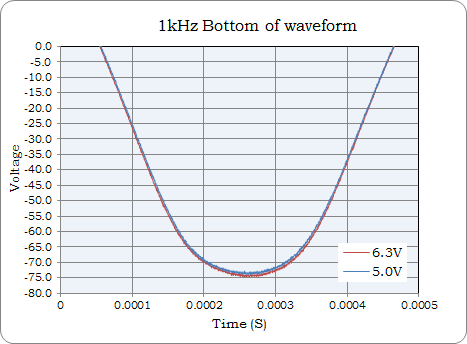I have a transformer from an old Linear Diatonic cage amplifier. How old? Well the 32uF+32uF can capacitor has May '58 as the date, but they didn't have just-in-time delivery in those days so I would put it at very early 60's best case. It was originally a two ECC83 + EL84 output with an EZ80 rectifier. It also had an auxiliary 6.3V and HT (B+) socket on the back, so I knew it had some capacity left over. It got put into a guitar amp and became three ECC83 + EL84 output +EZ81 rectifier. (I know, EZ81 is a 6.3V version of EZ80, but I had a new one and it worked OK.)
Now I want FOUR (new preamp + FX loop) ECC83 + EL84, but this may be pushing it a bit, and the last thing I want to do is slowly cook the transformer. If I lose the rectifier valve and go for a semiconductor bridge with a zener to drop the voltage back then I could possibly run the additional valve from the now unloaded 5V heater winding and reduce the total load on the transformer. The light heater loading of ~0.3A should allow the voltage to rise above 5V or safeguard from a low mains supply, but after looking on the net I could find very little in HARD figures. Most advice I saw was that this possibly won't work, with one reliable source saying yes it will be OK. (Valve Wizard)
The only way to decide was to go measure the configuration I was going to use. The measurement below used a DC lab supply for the heater. The voltage supply I have is limited to 210V so I couldn't test with a higher value. The valve was a JJ-Tesla ECC83S with about 50 hours on the clock. I would be looking at the 1-2-3 connected part of the triode. The other half was not connected and the heater was between pins 4 and 9 only. In test this would mean that the valve would be colder than if both heaters were working, but I think of it as margin.
 | ||
| Test Circuit. R3 is selectable as 120k or 240k |
With a 1V pk-pk test signal applied to the test circuit I got an output swing of 54.1V pk-pk with an anode resistance (R3) of 120k. With R3 = 240k the swing was 60.2V which is pretty much on the money. Spice simulation came out as 55.16V for 120K and 65.5V for 240K, so close enough.
Putting a 4V pk-pk input swing on the input it would drive the output into saturation. This should highlight any obvious weakness in using 5V. Firstly I looked at the negative side as this represents the largest current through the valve.
 |
| 6.3V vs 5V. Input = 4V pk-pk input 210V supply voltage. |
There is no huge difference to be seen between either heater voltage, the 5V heater gain (blue) looks just shy. The top of the waveform should be well saturated so we will check that next.
 | |
| As above.... |
The 5V heater is again a little shy of the 6.3V setting, but the behaviour entering and exiting saturation is pretty much the same. When lowering the input swing and operating in the available linear area the 5V gain is slightly lower but otherwise perfectly useable. Even at a 4V heater voltage the valve is still working in a healthy manner. With a 3V heater voltage the gain has dropped, but this is just experimental data.
So what conclusions does this present. For me and the new guitar amplifier, I'll happily put the first valve with both heaters on the 5V supply. Both stages are below maximum gain anyway. Some voices on the net did say I'll ruin the valve this way, but I found a table in an old design book which showed extended life extending to thousands of hours so I am happy with that. I will also consider putting a series resistor in all the 6.3V supplied preamp valves from pin 9 to the centre pin of the base and then to the heater wiring. A 2.2 Ohm resistor should reduce the switch on current in the heater from 1 Amp to ~600mA whilst dropping the working voltage to ~5.68V (0.615V drop or ~82% of full heater dissipation) This should have virtually no effect. If it does, then 1 Ohm should be fine.
On the other side of the coin. I should possibly see if I can get a more representative voltage for the supply, 210V is sort of low.
EDIT / UPDATE 1
Below is with a 270V power supply with 6.3V and 5V heaters compared. This last test had both heaters wired in circuit. No change from previously observed measurements including at full saturation.
 |
| 240K and 1.2V input. 73V pk-pk swing. |
EDIT / UPDATE FINAL
I have an _OLD_ Mullard Ecc83/12AX7, silvering gone spotty really is shot. God knows how many hours. It still has some output but very non-linear. It normally sits on my desk as an ornament. In the 270V HT / B+ test it performed equaly badly with 6.3V and 5V heater voltages. The 6.3V specification seems to have a lot of margin built in. Just remember to include mains supply tollerance etc. when looking at your own transformer!










